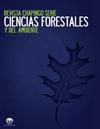Chemical-mechanical damage caused by the brown-rot fungus Gloeophyllum trabeum (Pers.) Murrill on Pinus pseudostrobus Lindl. wood
IF 0.6
4区 农林科学
Q3 Agricultural and Biological Sciences
Revista Chapingo Serie Ciencias Forestales Y Del Ambiente
Pub Date : 2020-04-30
DOI:10.5154/R.RCHSCFA.2020.05.033
引用次数: 1
Abstract
Introduction: Wood is susceptible to be used as a carbon source by fungal species damaging the wood. Its durability has been categorized according to its weight loss, without taking into account the decrease in the inherent physicochemical and mechanical properties. Objective: To evaluate how how weight loss affects the physicochemical and mechanical properties of Pinus pseudostrobus Lindl. wood exposed to brown-rot fungi Gloeophyllum trabeum (Pers.) Murrill. Materials and methods: Sawn timber pieces of P. pseudostrobus were inoculated with 50 mL of G. trabeum (106 UFC∙mL-1). Periodically (zero, three, six and nine months) and with the help of a universal testing machine, parallel compression (PC), static bending (SB) and perpendicular compression to the grain (CPG) were evaluated, and holocellulose, cellulose and lignin were quantified. Results and discussion: After nine months of interaction with G. trabeum, the pieces of wood were resistant to degradation, taking into account only weight loss. However, the chemical-mechanical properties evaluated showed that the fungus produced thinning and rupture of the tissue cells causing significant decrease in SB (100 to 56 N∙mm-2) and CPG (42.2 to 20.2 N∙mm-2), which reduced its resistance to mechanical stress. Conclusions: Wood exposed to fungal degradation is significantly affected in its mechanical properties, disqualifying it for construction. The damage is not reflected in the aesthetics of the material, which is surprising, since the common user of pine wood would not be able to notice the problem.褐腐真菌Gloeophyllum trabeum (Pers.)的化学-机械损伤伪松研究进展。木
简介:木材易被破坏木材的真菌用作碳源。其耐久性根据其重量损失进行了分类,没有考虑固有物理化学和机械性能的降低。目的:评价失重对假苍松理化和力学性能的影响。暴露于褐腐真菌Gloeophyllum trabeum(Pers.)Murrill的木材。材料和方法:用50mL trabeum(106UFC∙mL-1)接种P.pseudostrobus的锯木片。定期(零个月、三个月、六个月和九个月),在通用试验机的帮助下,对平行压缩(PC)、静态弯曲(SB)和垂直颗粒压缩(CPG)进行评估,并对全纤维素、纤维素和木质素进行定量。结果和讨论:在与trabeum相互作用九个月后,仅考虑重量减轻,这些木材具有抗降解性。然而,评估的化学机械性能表明,真菌导致组织细胞变薄和破裂,导致SB(100至56 N∙mm-2)和CPG(42.2至20.2 N∙mm-2)显著降低,从而降低了其对机械应力的抵抗力。结论:暴露于真菌降解的木材的力学性能受到显著影响,不适合施工。这种损坏并没有反映在材料的美观性上,这令人惊讶,因为松木的普通使用者不会注意到这个问题。
本文章由计算机程序翻译,如有差异,请以英文原文为准。
求助全文
约1分钟内获得全文
求助全文
来源期刊
CiteScore
1.20
自引率
16.70%
发文量
0
审稿时长
>12 weeks
期刊介绍:
The Revista Chapingo Serie Ciencias Forestales y del Ambiente (RCHSCFA) is a scientific journal that aims to raise awareness of high-quality research products related to forest, arid, temperate and tropical environments in the world. Since its foundation in 1994, the RCHSCFA has served as a space for scientific dissemination and discussion at a national and international level among academics, researchers, undergraduate and graduate students, forest managers and public/private entities that are interested in the forest environment.
All content published in the journal first goes through a strict triple-blind review process and is published in the following formats: Scientific Articles, Review Articles, Methodologies, Technical or Technological Notes.

 求助内容:
求助内容: 应助结果提醒方式:
应助结果提醒方式:


